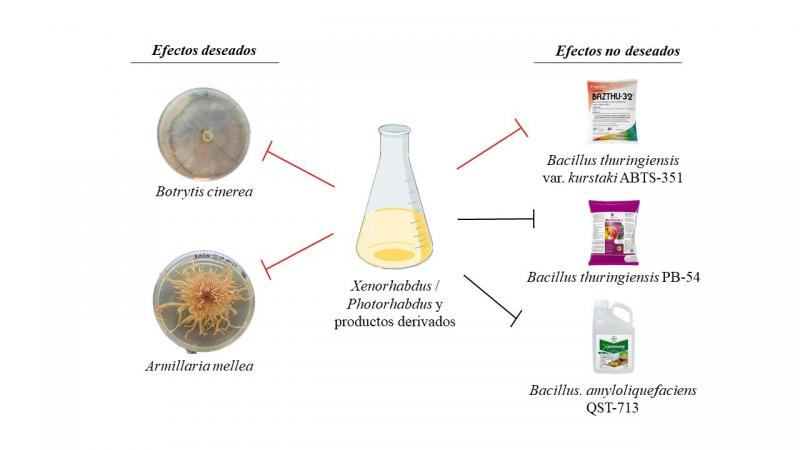Bacteria vs. Fungi? A Promising Alternative for Sustainable Viticulture
The intensive use of fungicides in agriculture raises concerns not only due to their environmental impact and risks to workers’ health, but also because the emergence of new fungal diseases is increasing reliance on these chemical products. In this context, the In-VID group at the ICVV has evaluated the potential of Xenorhabdus and Photorhabdus—two symbiotic bacteria of entomopathogenic nematodes—as biocontrol agents against pathogenic fungi, both in soil and on the aerial parts of plants. Using vineyards as a model agroecosystem, the study assessed their effectiveness against Botrytis cinerea (gray mold) and Armillaria mellea (root rot). It also analyzed possible unwanted effects on beneficial bacteria commonly used in biological control of fungal diseases: Bacillus thuringiensis var. kurstaki ABTS-351, B. thuringiensis PB-54, and B. amyloliquefaciens QST-713.
The results were very promising. On one hand, the production of toxins by X. nematophila depended on the culture medium and fermentation time. In general, the "Nutrient Agar" and "Tryptone Soy" media enabled the production of more toxins in les time than the “Luria Bertani” media, which significantly inhibited the growth of B. cinerea, with inhibition rates reaching up to 74.3%. Against A. mellea, both cell-free supernatants and unfiltered cultures of X. nematophila and P. laumondii considerably reduced fungal growth, with the unfiltered cultures being the most effective. On the other hand, the effect on beneficial bacteria was highly selective: only one commercial strain of B. thuringiensis was affected, while the others showed no sensitivity.
In summary, these bacteria not only act as biocontrol agents against fungi but could also contribute to maintaining a healthier microbial balance in agricultural soils. While the findings are encouraging, further research is needed to optimize their use in integrated pest and disease management strategies.
This study is part of the results from the National Plan project PID2022-136487OB-I00, funded by MCIN/AEI/10.13039/501100011033, by “ERDF A way of making Europe,” and by the Instituto de Estudios Riojanos (IER), Government of La Rioja (Spain), ref. 11/2023.
For more information:
Open Access publication of the article:
Vicente-Díez, I., Dueñas-Hernani, J., Campos-Herrera, R., 2025. Antifungal activity of Xenorhabdus and Photorhabdus against aerial and soilborne grapevine pathogens: varying efficiencies and non-target effects. Biological Control, 205, 05759. Doi: https://doi.org/10.1016/j.biocontrol.2025.105759
Open Access publication of the dataset in Digital.CSIC:








